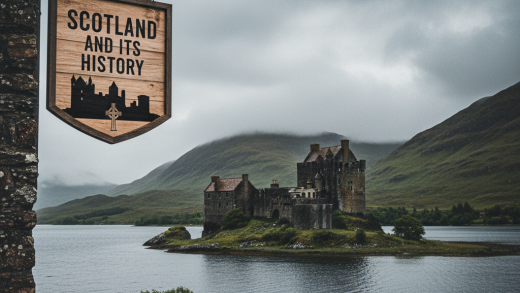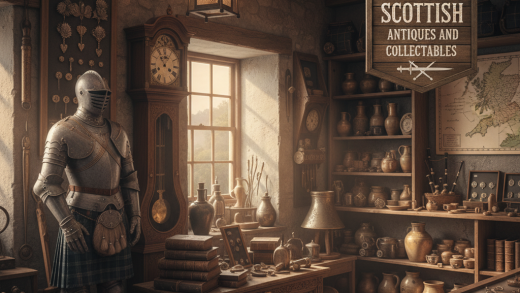
The Battle of Largs (2 October 1263) was a decisive, albeit small battle between the kingdoms of Norway and Scotland, on the Firth of Clyde near Largs, Scotland. Like the Japanese victories over the Mongol Invasions at roughly the same time (and for many of the same reasons) or the much later Battle of Coral Sea, Scotland achieved the end of 500-hundred years of Norse Viking depredations and invasions despite being tremendously outnumbered without a one-sided military victory in the ensuing battle. That said, the victory in detail caused the complete retreat of Norwegian forces from western Scotland and the realm entered a period of prosperity for almost 40-years. The tactical decision at Largs thus led to a sweeping strategic victory that ended in Scotland purchasing the Hebrides Islands and the Isle of Mann in the Treaty of Perth, 1266. Victory was achieved with a crafty three-tiered strategy on the part of the young Scottish king, Alexander III: plodding diplomacy forced the campaign to bad weather months and a ferocious storm ravaged the Norwegian fleet, stripping it of many vessels and supplies which made the forces on the Scottish coast vulnerable to a spoiling attack which forced the Norwegians into a hasty retreat that was to end their 500-years of invasion and leave Scotland to consolidate its resources into building the nation. The conflict formed part of the Norwegian expedition against Scotland in 1263, in which Haakon Haakonsson, King of Norway attempted to reassert Norwegian sovereignty over the western seaboard of Scotland.
Since the beginning of the 12th century the Largs/Ayrshire region of Scotland had lain at the periphery of the Norwegian realm, ruled by magnates who recognised the overlordship of the kings of Norway. In the mid-13th century, two Scottish kings, Alexander II and his son Alexander III, attempted to incorporate the region into their own realm. Following Alexander III’s early,failed attempts to purchase the islands from the Norwegian king, the Scots launched military operations to end the issue altogether by asserting royal sovereignty over all of Western scotland. Haakon responded to the Scottish aggression by leading a massive fleet from Norway, which reached the Hebrides in the summer of 1263, thought to number in the thousands when consoldiated en masse. Realizing that the Scots were tremendously outnumbered by an experienced and mobile enemy, Alexander III sought a protracted diplomatic intervention that would buy time to acquire more troops and possibly force the Norwegians into the stormy autumn and winter months where an invasion could be stalled due weather. By late September, Haakon’s fleet occupied the Firth of Clyde and the temperate days–such as they are on the West Coast of scotland–were almost at an end. When negotiations between the kingdoms inevitably broke down, Haakon brought the bulk of his fleet to anchor off the Cumbraes poised to invade Scotland at a site of his choosing.
On the night of 1 October, during a bout of stormy weather, several Norwegian vessels were driven aground on the Ayrshire coast, near present-day Largs. On 2 October, while the Norwegians were salvaging their vessels, the main Scottish army arrived on the scene. Composed of infantry and cavalry, the Scottish force was commanded by Alexander of Dundonald, Steward of Scotland. The Norwegians were gathered in two groups: the larger main force on the beach and a small contingent atop a nearby mound. The advance of the Scots threatened to divide the Norwegian forces, so the contingent on the mound ran to rejoin their comrades on the beach below. Seeing them running from the mound, the Norwegians on the beach believed they were retreating, and fled back towards the ships. There was fierce fighting on the beach, and the Scots took up a position on the mound formerly held by the Norwegians. Late in the day, after several hours of skirmishing, the Norwegians recaptured the mound. The Scots withdrew from the scene and the Norwegians reboarded their ships. They returned the next morning to collect their dead. With the weather deteriorating, Haakon’s fleet sailed to Orkney to overwinter.
The battle of Largs has been characterized by later historians as a great Scottish victory but, as discussed, its strategic ramifications far outstripped its tactical cost as it only involved a small part of the Norwegian fleet. With his fleet and forces strewn about the Hebrides, Haakon fully intended to continue to campaign after spending the winter in Orkney and reconcentrating his forces but he was unexpectedly taken ill in the dismal climate and died there. In part, his illness was thought to have been caused by the stresses he endured in the long campaign and the difficult, damp environment of the Orkney Islands. The protracted diplomacy that had slowed his invasion had ultimately helped seal his own fate as well. With Haakon’s death, his successor, Magnus Haakonarson, King of Norway, signed the Treaty of Perth three years after the battle, leasing Scotland’s western seaboard to Alexander III in return for a yearly payment. This lease became permanent, but the Kingdom of Scotland eventually stopped paying the Norwegian crown for the islands when Norway became distracted by civil wars.
Although the Battle of Largs’ contemporary records were largely lost to history with the loss of the Scottish archives in the wars of independence, it is for historians to day to judge it by its ultimate, easily understood consequence: the end of a multi-century era of Norse invasion. The Battle greatly influenced clan history, especially that of the Boyd’s and the Cunningham’s, both of which pointed directly to participation in this battle as key to the grant of lands in Ayrshire. In the case of the Boyd family, its motto “Confido” (I Trust) was a direct quote from Alexander III at Largs. Alexander III depended on Boyd’s detachment to keep the Norwegians off the Gold Berry Hill and enveloped on the beach. The name “Gold Berry” was placed under their early heraldic devices.
The battle is commemorated in Largs by an early 20th-century monument, and festivities held there annually since the 1980s.
The main Norwegian source for the battle is Hakonar saga Hakonarsonar, a contemporary account of the life of Hakon Haakonarson, King of Norway (d. 1263), composed by the Icelandic historian Sturla Thordarson (d. 1284). Although the saga describes the events purely from the Norwegian perspective, its narrative of the battle appears to have been drawn from eye-witness accounts, and it is the most detailed source available for the Scottish–Norwegian conflict since many contemporary Scottish archival hodings are lost to history. A contemporary Scottish perspective of the events is preserved in a brief entry within the Chronicle of Melrose. First penned at Melrose Abbey in the last quarter of the 12th century, the chronicle was further extended and supplemented from time to time into the late 13th century. It is an important historical source for the mediaeval Scottish realm. Clan and remaining royal records of proerty and titles subsequent to the event are also insightful
Further information: Scandinavian Scotland, Kingdom of the Isles, and Scottish–Norwegian War
Viking depredations have been recorded in the British Isles since the late 8th century, and Scandinavian settlement on Scotland’s western-seaboard may have begun before the turn of the 9th century. Claims to this region by Norwegian kings date to the turn of the 12th century, when Magnus Olafsson, King of Norway (d. 1103) established himself in the Hebrides and the Isle of Man (Mann). Direct Norwegian control ended with Magnus’ death, after which the Hebrides and Mann, known to the Norwegians as the “Southern Isles”, were controlled by local dynasties for over a century and a half. In the first half of the 13th century, the seaboard was controlled by two main power-blocks: one consisting of the Mann, Lewis and Harris, and Skye—controlled by the patrilineal descendants of Godred Crovan (d. 1095); the other consisting of mainland territories in Argyll, and the islands of Islay, Jura, Mull, and possibly Uist—controlled by the descendants of Somerled (d. 1164). As part of the far-flung, early 13th century Norwegian realm, these island rulers recognised the overlordship of Haakon Haakonarson, King of Norway (d. 1263).
The Norwegian realm in 1263, at about the time of the Battle of Largs
The first half of the 13th century was a period of consolidation for both Scottish and Norwegian kings. The Norwegians, under Haakon, overcame a period of internal strife, from 1161 to 1208, and oversaw the submission of the Faroe Islands, the Greenland settlements, and Iceland, in the mid 13th century. The Scots, under Alexander II, King of Scots (d. 1249), extended royal authority into the northern Highlands, Argyll, and Galloway. The king also had wanted to incorporate the western seaboard into the Scottish realm. In 1230, Scottish aggression against the Isles and interference forced the Norwegian king to pacify the region. In 1249, after attempting to purchase the Isles from Haakon, Alexander II launched a campaign of his own, deep into Argyll and into the Hebrides. Unfortunately for the Scots, their king died suddenly on the verge of conquest. Since his son and successor, Alexander III (d. 1286), was only a boy at the time, the Scottish realm suffered through a lengthy and troubled minority. In consequence, it wasn’t until the 1260s that the king looked west, and attempted to finish what his father had so nearly accomplished.
In 1262, a year after another unsuccessful attempt to purchase the Isles, Scottish forces launched an attack upon Skye. Haakon’s response to the invasion was to mastermind a massive military expedition of his own. Described by the Icelandic Annals as the largest force to have ever set sail from Norway, the fleet reached the Isles in the summer of 1263. After receiving only a lukewarm reception from his vassals in the region, Haakon’s forces reached the Firth of Clyde, after his men had secured several castles, and undertook raids into the surrounding mainland. With the Norwegian fleet anchored off Arran, the Norwegians and Scottish embassies fiercely debated the sovereignty of the Islands of the Clyde. When talks broke down, Haakon dispatched a fleet of Islesmen to raid into Loch Lomond, and to ravage Lennox. Meanwhile, the main Norwegian fleet repositioned itself between the Cumbraes and the Ayrshire coast.
While lying off the Cumbraes, on the night of 30 September, Haakon’s fleet was battered by stormy weather. During the night, the saga records that a merchantman dragged its anchor and was driven aground. The following morning, it and four other vessels were floated off by the rising tide but carried by the current towards the Scottish mainland where they ran aground again. The crews of the beached vessels were soon harassed by a small force of Scots armed with bows. After the Norwegians had suffered some casualties, Haakon sent reinforcements ashore, and the Scots fled the area. Haakon’s reinforcements remained ashore for the night, and the Norwegian king himself came ashore to oversee the salvage operation the next morning.
Discover more from WILLIAMS WRITINGS
Subscribe to get the latest posts sent to your email.




